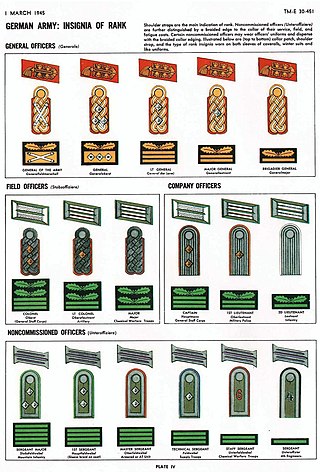Konteradmiral is a senior naval flag officer rank in several German-speaking countries, equivalent to counter or rear admiral.
Generalmajor is the Germanic variant of major general, used in a number of Central and Northern European countries.
Generalleutnant is the German-language variant of lieutenant general, used in some German speaking countries.
Unteroffizier is a junior non-commissioned officer rank used by the Bundeswehr. It is also the collective name for all non-commissioned officers in Austria and Germany. It was formerly a rank in the Imperial Russian Army.
Flotilla admiral is the lowest flag rank, a rank above captain, in the modern navies of Belgium, Bulgaria, Denmark, Finland, Germany, Sweden and Lithuania. It corresponds to the rank of commodore in the navies of the United Kingdom and certain other countries or rear admiral in the navy of the United States.
Brigadegeneral is the Germanic variant of Brigadier general.
Korvettenkapitän is the lowest ranking senior officer in a number of Germanic-speaking navies.
General is the highest rank of the German Army and German Air Force. As a four-star rank it is the equivalent to the rank of admiral in the German Navy.

In the German military, Waffenfarbe is a visual method that the armed forces use to distinguish between different corps or troop functions in its armed services. The Waffenfarbe itself can take the form of the color of the collar patch, of the piping (embellishment) around the shoulder boards or shoulder marks, or—for enlisted ranks—of the piping around the collar and the garrison cap (Schiffchen).
Oberstarzt (OTA) is a military rank in German speaking armed forces. It denotes a medical staff officer surgeon or medical staff officer dentist and is comparable to Colonel (de: Oberst) or Captain (naval) (de: Kapitän zur See) NATO-Rangcode OF5 in anglophone armed forces.

The Heer as the German army and part of the Wehrmacht inherited its uniforms and rank structure from the Reichsheer of the Weimar Republic (1921–1935). There were few alterations and adjustments made as the army grew from a limited peacetime defense force of 100,000 men to a war-fighting force of several million men.
Oberstabsarzt is a military rank in German speaking armed force. It describes a medical staff officer surgeon or medical staff officer dentist comparable to major or lieutenant commander NATO-Rangcode OF3 in anglophone armed forces.
Generaloberstabsarzt and Admiraloberstabsarzt are the top Joint Medical Service OF8-ranks of the German Bundeswehr. The equivalent to this ranks in the Heer is Generalleutnant and in the German Navy the Vizeadmiral.
Generalarzt is the designation of a military rank as well as the official title in German speaking armed forces. It is equivalent to the Admiralarzt / Generalapotheker and Brigadegeneral / Flottillenadmiral.
Oberfeldarzt is a military rank in German speaking armed forces. It denotes a medical staff officer surgeon or medical staff officer dentist and is comparable in rank to lieutenant colonel or (naval) commander NATO-Rangcode OF4 in anglophone armed forces.
Stabsarzt, in English Staff Surgeon, is a military commissioned officer rank in German speaking armed forces. In the German Bundeswehr and the former Wehrmacht and Reichswehr, it describes a qualified or licensed surgeon or dentist who practises military medicine, with a rank equal to captain in the army and the air force or lieutenant in the navy. In the Austrian and Swiss armies, the rank is Hauptmann.

Oberarzt, literally meaning "senior physician," in English known as first lieutenant (Dr.), was a military commissioned officer rank in the Austro-Hungarian Common Army until 1918, and in the German Reichswehr and Wehrmacht until 1945.
Assitenzarzt was a military rank in the Austrian-Hungary Common Army until 1918 and in German Reichswehr and Wehrmacht until 1945.

Unterarzt was a military rank in the German Reichswehr and Wehrmacht until 1945.
Feldunterarzt was a military rank in the German Wehrmacht until 1945. It was established additional to the Unterarzt July 25, 1940. Uniform and shoulder board were identical to the Fahnenjunker-Oberfeldwebel (Oberfähnrich), however without the double unterofficer galloons. The Gothic letter A between the two silver felwebel stars indicated the membership to the Military Medical Academy in Berlin. The Feldunterarzt was an officer aspirant in the Military Health Service.









